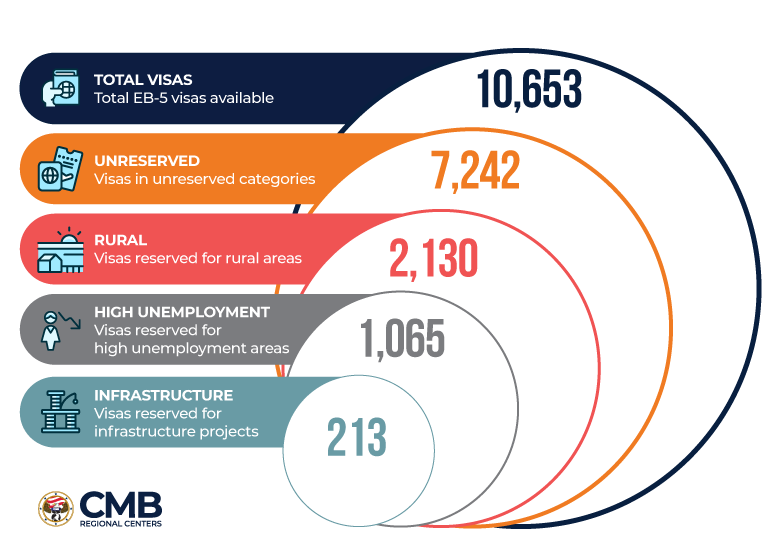
As of September 16, 2025, the Department of State (DOS) has reached the annual limit on EB-5 visas from the unreserved category for fiscal year 2025. The DOS statement indicated that the annual limit included carryover of unused EB-5 reserved visas (Rural, High Unemployment Area, and Infrastructure) from Fiscal Year 2023. As a result, embassies and consulates may not issue any further unreserved visas for the rest of the fiscal year, which ends September 30th, 2025.
EB-5 Visa Category Overview:
Each year, the Immigration and Nationality Act (INA) caps the number of EB-5 visas. Specifically, INA 203(b)(5) allocates 7.1% of the worldwide employment-based visa limit (150,000 in FY25) to EB-5 visas. Of these 10,653 available EB-5 visas, the INA designates 68% (~7,242) for unreserved categories, and 32% (~3,408) for reserved categories including 20% for rural, 10% for High Unemployment Areas, and 2% for infrastructure.

The unreserved category is the largest pool of applicants and includes both the pre-Reform and Integrity Act (RIA) I-526 petitioners and the post-RIA petitioners who are not in a reserved category. According to Lucid’s analysis, there are an estimated 39,238 unreserved visas in the backlog as of January 2025. While the final number of visas issued in FY25 is still unknown, it’s likely that the annual limit in FY25 took a healthy swipe at unreserved backlog. For reference, the DOS issued 14,501 unreserved visas in FY24, when the annual limit was capped in August 2024.
DOS issuing a larger number of unreserved visas is good news because it takes a bite out of the pre-RIA backlog. Since USCIS was slow to adjudicate reserved visas in FY22 and FY23, these became available to the large unreserved pool. In addition, reaching the unreserved cap also prevents potential EB-5 visas being lost to other employment-based categories.
Explaining the carryover in reserved visas
The INA explains that any unused reserve category visas will carry over to the immediate succeeding fiscal year. If they remain unused in that subsequent carryover year, the reserved visas become available to the unreserved category.
Unused reserve visas from 2023 added to the number of unreserved visas issued in FY25. This also occurred last year, when the unused reserve visas from 2022 were added to the FY24 unreserved annual limit.
Looking forward to FY26, of the ~3,653 reserved visas available in FY24, only 423 were issued. Because the recent DOS statement on the unreserved annual limit did not mention the reserved limit, we can assume that the FY25 reserved caps have not been reached either. According to the IIUSA data dashboard, DOS only issued 568 reserved visas as of May 2025 (7 months into the fiscal year). This equates to an average reserved visa issuance of ~81 per month. Therefore, DOS is on pace to issue ~974 reserved visas in FY25 (baring an unforeseen uptick in reserved visa issuance to close out the year). Assuming DOS taps the reserved carryover from FY24 (3,653) before dipping into the FY25 set-aside (3,409), there should still be ~2,680[1] carryover reserved visas from FY24 reallocated to the unreserved category in FY26.
Reserved Visa Concerns
While the delay in adjudicating I-526Es certainly benefits investors in unreserved categories, significant concerns remain for those petitioners in rural, high unemployment areas, and infrastructure projects. Since the passage of RIA in March 2022, USCIS has never reached the annual set aside cap for the reserved visas and the vast majority continue to rollover into the unreserved category.
However, CMB is optimistic that this could change as USCIS nears the completion of the remaining pre-RIA I-526s and diverts all their adjudication efforts to I-526Es with priority on the reserved categories. If this occurs, it is possible that the unused reserved visas from FY25 will remain in their intended place by rolling over and boosting FY26s reserved capacity.
IIUSA filed a lawsuit in 2024, seeking an injunction to prevent the rollover of reserved visas into the unreserved category, to help protect EB-5 investors in reserved categories Had USCIS properly implemented RIA in a timely manner, the reserved visas in FY23 and FY24 would have been used as intended. While the injunction was ultimately not successful, IIUSA heard the concerns of those investors and attempted to take action on their behalf. Our hope is that the adjudication developments in the coming year, as discussed above, will finally enable visa issuance up to the true set-aside cap for reserved visas.
Conclusion
DOS reaching the annual limit on unreserved EB-5 visas for fiscal year 2025 is beneficial to pre-RIA investors due to the reduction in their backlog. Concerns still exist for investors in reserved categories as their set-aside visas continue to rollover into the unreserved queue. USCIS’s goal for FY26 should be to prioritize reserved categories in the coming fiscal year. They have never been in a better position to do so, as the pre-RIA backlog of un-adjudicated cases dwindles. A renewed prioritization by USCIS would hopefully bring sufficient quantities of reserved petitioners to DOS for processing to finally reach the reserved EB-5 visa cap next fiscal year.
______


